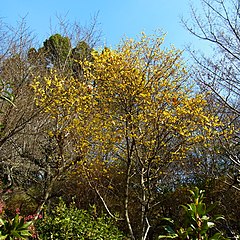
Native to China, this deciduous shrub is a member of the spicebush family, Calycanthaceae. The plant grows up to 15′ tall and has dark green, almond shaped leaves that are 2.5-6″ long and rough to the touch. From late winter to early spring fragrant yellow blooms appear on leafless stems. The flowers are waxy, cupped, and have purple centers. Branches of wintersweet can be forced into bloom in winter and will fill the whole room with their sweet scent. The genus name, Chimonanthus, comes from the Greek words Greek words Cheimonas, meaning winter, and anthos, meaning flower, and refers to the bloom time. The specific epithet, praecox, is the Latin word meaning early and refers to the bloom time. Photo Credit Wikipedia

Type: Deciduous flowering shrub.
Outstanding Feature: Fragrant flowers in late winter-early spring.
Form: Large mound.
Growth Rate: Slow.
Bloom: Fragrant, waxy sulfur-yellow flowers with purple-brown centers in late winter to early spring; produced on previous season’s growth.
Size: 10-15’ H x 8-12’ W.
Light: Sun to light shade.
Soil: Moist well drained; preferably acidic; tolerates a wide variety soils if not too dry or wet.
Hardiness: Zones 7-9.
Care: Since the flowers appear on the previous years’ growth, dead, diseased and a few old stems should be removed at ground level each year. Removing seed heads will increase flower production the following year.
Pests and Diseases: Susceptible to aphids, mites, leaf beetles but none cause serious problems.
Propagation: Seed; softwood cuttings.
Outstanding Selection:
Grandiflorus’ (deeper yellow flowers with red centers but less fragrant)
‘Luteus’ (darker gold flowers)
Comments: Needs a sheltered site against a wall or in a border. Shrub may take several years before it starts to bloom.
Photo Credit Wikipedia

yes ,I love this flowering tree very much! And I just made photos in my blog .It is blooming in the gardenes in the China!
Zhu limin,
We loved the gardens in China when we visited. You certainly have a a rich tradition of fabulous gardens. i hope that you will enjoy the website and get an idea of how we garden here in the US.
Karen
These are blooming now in North Carolina in January. Very fragrant but slow growing.
Arthur, Lucky you! especially since there has been considerable snow and cold so far.
Karen